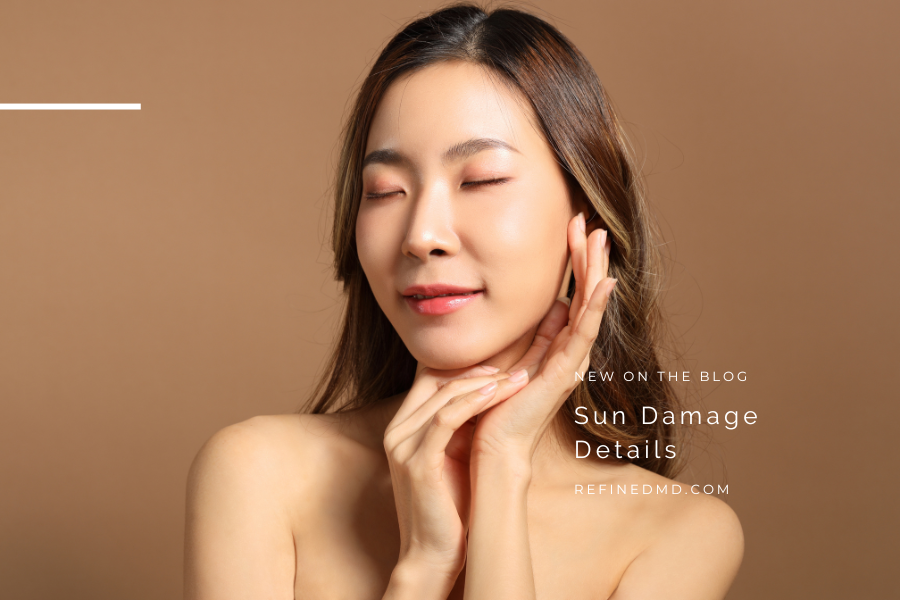
22 Mar Sun Damage Details
A sunburn is more than a summer rite of passage. It’s your body sending a clear message that serious sun damage has occurred—and at RefinedMD, we are dedicated to helping you prevent sunburns and treat the lingering effects. Although blistering sunburns are one of the leading causes of melanoma, the deadliest of any form of skin cancer, sunburns are not the only cause. Even without a sunburn, your skin is being damaged by the sun on a daily basis. Cloudy skies, winter months, windows, and sunscreen that has not been reapplied within 90 minutes are no protection from dangerous ultraviolet rays.
Protecting your skin from sun damage does more than keep you safe from painful sunburns. These best practices can save your life.
What is a Sunburn?
The sun has two main types of ultraviolet rays. UVA is long wave, while UVB is short wave. UVA has the power to deeply penetrate the skin, causing damage that might not be seen for years (if ever). UVB rays cause immediate damage, often presenting as a sunburn. These rays affect the top layers of skin, but also leads to lingering sun damage.
Sunburns are a sign of immediate sun damage. Just 10 minutes of UV exposure forces the body to start defending itself. This results in an inflammatory response, or distress signal, as the blood vessels dilate. This redness causes a lack of hydration, leading to skin tightening. As the skin thickens, melanin is created. Both sun tans and sunburns are your body’s way of protecting itself.
More Than a Sunburn
Peeling is one of the most annoying and obvious signs of a sunburn. It is the body’s way of getting rid of damaged cells. New skin is revealed as the body heals. Keep in mind that even with proper sun protection, damage can occur. This damage is usually invisible for many years and can include:
- Freckles and moles
- Hyperpigmentation
- Lines and wrinkles
- Precancerous and cancerous lesions
- Premature aging
- Telangiectasias (blood vessel dilation)
Preventing Sunburns
Preventing sunburns is your best course of action to avoid skin cancer, premature aging, and other signs of sun damage. Since skin can burn in just three minutes, it is important to remain vigilant. Use an SPF of at least 30 on a daily basis, and SPF 50 on days when you will be regularly exposed to UV rays. Make sure the sunscreen is high-quality, the ingredients are not hazardous, and that it has not expired. The best sunscreens, such as EltaMD, are available in our office.
There are various types of sunscreens. However, sunscreen is NOT sunblock. There is no way to fully block the sun’s rays besides avoiding them entirely. Here are some big terms you need to know:
Water-resistant: There is no such thing as waterproof sunscreen. However, some sunscreens are water-resistant. They still need to be applied regularly. If you will be spending the day swimming or in the water, reapply every 20 minutes.
SPF: The sun protection factor of a sunscreen tells you its strength. It can range from 15 to over 50. The higher the SPF, the more protection it offers.
Broad-spectrum: Only a broad-spectrum sunscreen is effective against both UVA and UVB rays. Always use a broad-spectrum sunscreen.
What if I Get a Sunburn?
Most people get sunburns at some point, no matter how careful they are. In most cases, sunburns will heal on their own and can be a good reminder to be extra-vigilant with sun protection. If you suspect a sunburn:
- Immediately get out of the sun’s rays. There is no way to reverse sun damage, but you can reduce additional damage.
- Stay hydrated. Sunburns dehydrate the body, and potentially put you at risk of severe dehydration.
- Take a cool bath or shower. Avoid exposing the skin to hot water as you heal.
- Apply a recommended soothing agent like aloe vera. Your dermatologist can recommend additional options.
- Take a safe pain reliever if necessary. Aspirin is safe for most people to reduce the pain.
- Avoid popping blister.
- If a sunburn is accompanied by a fever, chills, vomiting, or severe side effects, you may have sun poisoning. Seek immediate medical attention.
- Watch for changes to the skin during and after healing. Changes to moles may be a sign of precancerous or cancerous lesions. Schedule a skin check immediately.
On Your Side to Prevent and Heal Damaged Skin
If you have a sunburn, struggle with sun damaged skin, or want to learn more ways to protect yourself from sunburns, connect with RefinedMD today by calling the office or filling out the online form.
